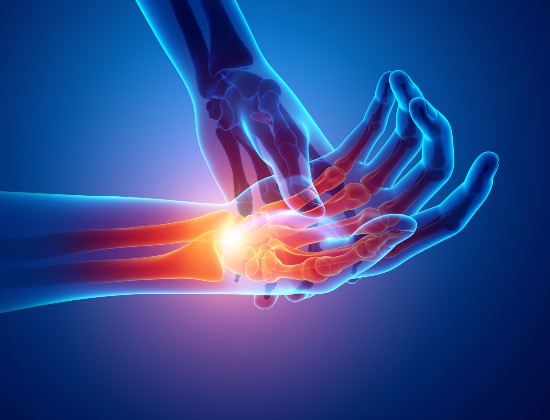Wrist arthroscopy
What is arthroscopy?
A small telescope (arthroscope) with a light source and a camera – about the width of a drinking straw - allows the surgeon to view the inside of the joint and treat a range of problems. Images can then be viewed on a television monitor in the operating theatre. Arthroscopy is usually carried out under a general anaesthetic as a day case. Because only tiny incisions are made, recovery time is much quicker than with conventional surgery.
Which hand and wrist procedures are performed with arthroscopy?
It can be used to diagnose and/or treat many conditions including:
- Chronic wrist pain
- Fractures
- Ganglions
- Ligament injuries
- Osteoarthritis
- Cartilage (TFCC) tears
What does it involve?
Arthroscopy is often performed as a day case procedure under a general anaesthetic. The surgeon usually makes two tiny incisions (cuts), one for the arthroscope and a second for the surgical instrument itself.
What can I expect immediately after surgery?
For the first few days you should keep your wrist elevated (raised above the heart) as much as possible and it can help to apply ice (crushed and wrapped in a towel) several times a day to reduce the swelling. Your specialist will also give you some gentle exercises to help restore strength and flexibility.
What are the advantages of arthroscopy?
- There is no cutting of muscles or tendons
- There is less bleeding during surgery
- The scar over the operation site is smaller than with conventional surgery. This helps with healing, as well as reducing permanent scarring
- The length of your hospital stay is likely to be shorter because the procedure is less invasive
- The healing and rehabilitation time can be shorter
What are the disadvantages of arthroscopy?
- As with any surgery, there is a risk of damage to nerves and other blood vessels
- Wrist arthroscopy is not suitable for everyone. Your specialist will be able to advise you about whether it’s right for your condition
- The surgeon may have to resort to open surgery if attempted arthroscopy is difficult
What about follow-up appointments?
Everyone is different, so healing and post-operative programmes vary from person to person. However, the schedule of follow-up appointments below is typical:
- 2 weeks - wound check and removal of stitches
- 6 weeks - follow-up appointment
- 12 weeks - follow-up appointment and discharge
How do I wash and shower?
During the first two weeks, keep the bandaged wrist totally dry; you can shower using a waterproof cover over the site. After that, you can shower as normal if the wounds have healed, but gently dab them dry.
What long-term outcomes can I expect after surgery?
This depends on the type of condition and the exact procedure you have had. Most people are able to return to full activity and sports within three to six months.
What are the risks?
Below is a guide to the risks of this type of surgery. Your surgeon will discuss these with you before your procedure and answer any questions you may have:
Infection: The chance of infection is less than 1% and can usually be treated with antibiotics. Significant consequences from infection are very rare (less than 0.5%)
Nerve damage: Small nerves that supply sensation to the skin near the operation site can be damaged, although the risk of this is small (less than 2%)
Deep Vein Thrombosis (DVT): There is no increased risk of DVT following hand surgery.
Important
This information is only a guideline to help you understand your treatment and what to expect. Everyone is different and your rehabilitation may be quicker or slower than other people’s. Please contact us for advice if you’re worried about any aspect of your health or recovery.


